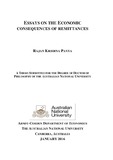Please use this identifier to cite or link to this item:
http://archive.nnl.gov.np:8080/handle/123456789/73| Title: | Essays on the economic consequences of remittances |
| Authors: | Panta, Rajan Krishna |
| Keywords: | Remittances Inward remittances International remittances |
| Issue Date: | 21-Feb-2018 |
| Abstract: | This thesis examines three issues relating to the role of remittances in the process of economic development: the impact on economic growth, the implications of remittances on the real exchange compared to other forms of financial inflows, and the impact of remittances on expenditure patterns of households in a major remittance-dependent country, Nepal. The issues are addressed in three self-contained essays, with a stage-setting introductory chapter and a concluding chapter which summarises the key findings. The essays are mainly empirical, but well informed by the relevant analytical literature. The empirical analysis makes use of the latest econometric techniques. Chapter 2 examines the debate on the impact of remittances on economic growth using a new panel dataset covering 74 developing countries over the period 1976–2010.The novelty of the analysis is that it probes possible nonlinearity and lagged effect of the hypothesized impact of remittances on economic growth using alternative specifications. The results suggest that remittances have a positive impact on growth, with the magnitude of the impact declining beyond a remittance-GDP ratio of 7 to 9 percent. But the marginal impact is not statistically significant. There is also no evidence to suggest that the impact of remittances on growth depends on financial deepening as some previous studies have suggested. Chapter 3 examines the impact of remittances on real exchange rate (RER) using the standard dependent economy model to derive the estimation equation. The analysis is based on a new panel dataset covering 105developing countries during 1980-2011. A key novelty of the paper is the use of a theoretically consistent new real effective rate (REER) index as the dependent variable. The index uses the wholesale price index (WPI) to measure foreign prices and the GDP deflator as the measure of domestic prices whereas the REER index of the IMF, which has been commonly used in in the previous studies, uses CPI to measure both prices. The results reveal that remittances lead to significant appreciation of RER, and the magnitude of appreciation depends on the nature of the exchange rate policy regime. One percentage point increase in the remittance to GDP ratio leads to an appreciation of RER by 0.5 percent and 1.08 percent in the countries with the fixed and flexibles exchange rates, respectively. However, the impact is not statistically significant under both exchange rate regimes when the IMF index is used as the alternative measure of RER. There is also evidence that the degree of appreciation associated with remittance inflow is significantly higher compared to the inflows of official development assistance and foreign direct investment. The fourth chapter examines the impact of remittances on the expenditure patterns of households in Nepal using a panel dataset constructed from three rounds of the Nepal Living Standard Survey (1995, 2003 and 2010). The findings reveals that, contrary to popular perception about unproductive use of remittances, remittance-receiving households spend a higher proportion of total consumption expenditure on education and health. |
| Description: | A thesis submitted for the degree of Doctor of Philosophy Of The Australian National University, Arndt-Corden Department of Economics, the Australian National University, Canberra, Australia, 2016. |
| URI: | http://103.69.125.248:8080/xmlui/handle/123456789/73 |
| Appears in Collections: | 300 Social sciences |
Files in This Item:
| File | Description | Size | Format | |
|---|---|---|---|---|
| Thesis_Rajan_Krishna_Panta.pdf | 2.59 MB | Adobe PDF |  View/Open |
Items in DSpace are protected by copyright, with all rights reserved, unless otherwise indicated.